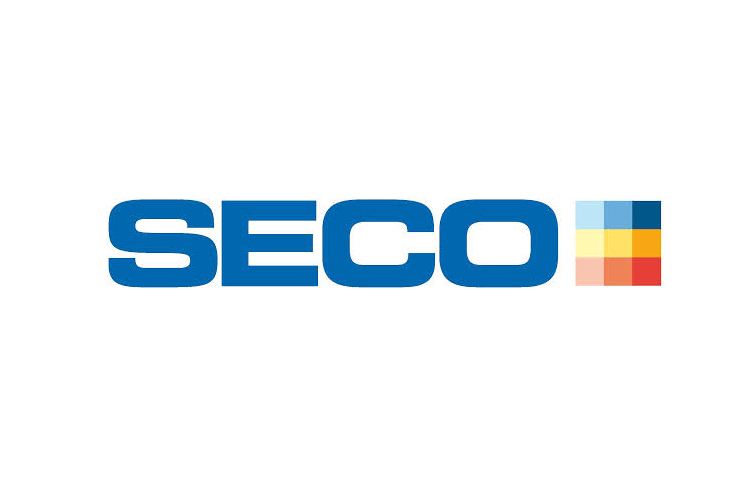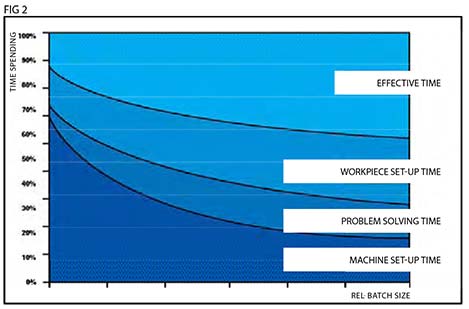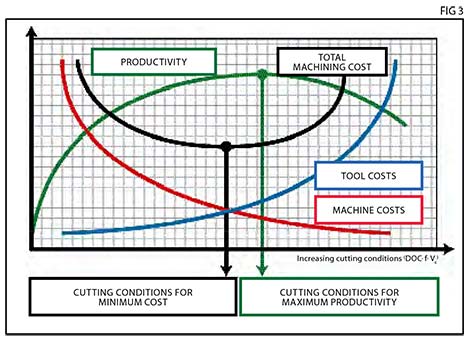Patrick De Vos is Seco’s Chief Technical Education Manager discusses practical ways to improve productivity. Read on..
My Previous article discussed the measures you can take to reduce insert usage and costs in a simple manner. However, real productivity increases and machining cost reductions (accounting for all elements) require more drastic adjustments (see fig 1).
The first condition is having the right tools, adapted to the circumstances (the machine and material). Next, the most efficient cutting conditions for that tool need to be determined. Only then will real productivity increases and cost reductions be possible.
The Right Tool
Defining what the right tool is for the job is not easy. Much depends on the workpiece batch sizes and the complexity of the actual work (see fig 2).
One approach is to perfectly adjust the tool to the process to be completed. All the variables need to be taken into account to do this, guaranteeing that for each processing step, the effective time (the actual machining time) is used as efficiently as possible. The downside to this approach is that it requires a wide range of dif ferent tools. This will increase the idle times (machine/tool adjustment time), reducing the available effective time. In short, this gives a shorter effective time, but one that is used optimally.
The other approach employs the use of universal tools. This method will reduce the idle times (fewer tools to adjust and maintain) and as such, extends the available effective time. However, the use of the effective time will not be as efficient because the tools are not adjusted optimally to the process.
The best approach will be a mix of the two alternatives. A practical application is possible only through “simulation”: Comparing the alternatives, determining the time used and deciding which approach provides the best overall solution.
Effective Cutting Conditions
Efficient cutting conditions give the best possible combination of low machining costs and maximum productivity (see fig 3).
Evidently, the choice of cutting conditions determines the processing time and the degree of productivity (number of processing steps per time unit) (for pre-determined tools). As the cutting conditions increase, the machining time for a process decreases. This implies higher productivity – more processing steps per time unit are carried out. However, if the cutting conditions are set too high, productivity will fall because too much time is lost on maintaining the tools (replacing worn cutting edges and repairing spare parts) thus increasing the idle times.
If the cutting conditions increase, the machine costs per processing step will fall thanks to shorter machining times. At the same time, tool costs per processing step will increase due to shorter tool life and the fact that more cutting edges will be needed.
Higher cutting conditions mean higher tool costs per processing step, but this increase is compensated by lower machine costs per processing step. Adding these up (= total machining cost) a combination of cutting conditions emerges with minimal total machining costs.
For lower cutting conditions, the machining costs increase due to the higher machine costs in general. If the cutting conditions are too high, the machining costs will increase, since the tool costs increase more rapidly than the machine costs drop.
The area determined by the cutting conditions with minimum machining costs and the cutting conditions for maximum productivity is referred to as the HiE (High Efficiency) area.
In practice, determining the HiE cutting conditions is an exercise that requires a fair amount of calculating. This means that many machining operators are reluctant to determine them. Moreover, is it actually worth the hassle? Does the time needed to determine efficient cutting conditions weigh up against the potential savings? Seco Business Solutions offers a number of useful tools that make it easier to put these considerations into practice.
In order to select the right tool and determine the correct basic cutting conditions, Seco offers its customers WinTool and SecoCut. WinTool is an instrument that helps you select and manage tools fast. SecoCut helps users to determine for every tool the most efficient cutting conditions. This includes the optimum combination of maximum production with lowest machining costs. Wintool and SecoCut help to create a sound starting position simply and quickly. This starting position then serves as a platform to make further improvements, should they be necessary.
Seco PCA is a system that determines the most profitable processing method and cutting conditions for any cutting process. The simulation compares the various alternatives available (method, tools and cutting conditions). These alternatives are weighed up and compared for their processing time (productivity) and machining costs. This allows the user to quickly determine which alternative he prefers and what the implications of his choice are.
Up to 30% Savings
PCA studies carried out by Seco Tools in customers’ workshops have shown that cost savings and productivity increases of more than 30% are feasible. In a future article, we will take a closer look at the options of Seco PCA and how this system helps Seco Tools clients realise realistic productivity increases and cost savings.
If you wish to implement the options of a PCA study for your machining activities and want to learn more about how much you can save, please contact your Seco representative.
About Author:
 Patrick de Vos, Global STEP Master (Seco Technical Education Programme), Seco Tools. Patrick has led the creation of STEP (Seco Technical Education Programme) and has the global responsibility for technical education activities for SECO employees and customers worldwide.
Patrick de Vos, Global STEP Master (Seco Technical Education Programme), Seco Tools. Patrick has led the creation of STEP (Seco Technical Education Programme) and has the global responsibility for technical education activities for SECO employees and customers worldwide.
E: patrick.de.vos@secotools.com





